An Operational Framework for Urban Vulnerability to Floods in the Guayas Estuary Region: The Duran Case Study
Abstract
1. Introduction
2. Materials and Methods
2.1. Study Area: Duran as a Socio-Ecological System
2.2. Operational Conceptual Framework of Vulnerability: Applied to a Coastal City
2.3. Flood Vulnerability Index, Methodologies for Weighting Indicators
2.4. Variables: Exposure, Sensitivity, and Adaptive Capacity Indexes of the Duran
- The flux density combined with the slope and geomorphology.
- Land use and vegetation cover as well as soil texture.
- Hydrogeology in relation to its potential to generate areas susceptible to flooding.
- Rains as a trigger for floods.
2.5. Data Processing
2.6. Spatial Autocorrelation and Local Spatial Identification Patterns (LISA)
3. Results
3.1. Understanding the Vulnerability of the City: Exposure, Sensitivity, and Adaptive Capacity
3.2. Selecting a Method for an Operational City Vulnerability Analysis
4. Discussion
4.1. The Need of an Operational Framework for Cities and Municipalities in Ecuador: In the Policy Context
4.2. Underlying Drivers of Social Vulnerability to Flooding: Population and Informal Settlements
4.3. Spatial Distribution of the Flood Vulnerability Index
- (i)
- Cluster high–high shows urban sectors with a high FVI that have as neighbors’ other sectors also with high FVI. Applying a statistical confidence level of 0.95, a statistically significant cluster is observed that integrates 36% of the Duran’s urban sectors. This cluster includes all the areas of informal settlements which are highly sensitive to flooding as we analyzed in Section 4.2.
- (ii)
- The low–low urban sectors with low FIV and whose neighbors are in the same condition; however, within these sectors there is a population with precarious housing and socio-economic conditions, located in the skirt’s hills where basic infrastructure systems have not yet been built due land informality, suggesting that the vulnerability analysis needs to include the social-urban development context in the analysis.
- (iii)
- The high–low cluster, composed of urban sectors with FVI between medium and high that have experienced flood events even without rains but only with tidal events such as the Abel Gilbert sector, however with neighbors in the opposite situation. Some periurban areas such as Fincas Delia are also in this group because vulnerability is exacerbated in rural areas due to lack of city resources (adaptive capacity).
4.4. Limitations and Further Risk Research
5. Conclusions
- Rapid urbanization processes, due to different climatic, political and economic circumstances, has led to informal settlements in hazardous areas. City data and local context knowledge of these underlying factors is critical in order understand the complex dynamics of vulnerability and for developing sustainable urban planning, disaster risk reduction strategies and climate resilient cities.
- Although we promote the use of census-based indicators for vulnerability assessments at the city and neighborhood levels, we conclude that census data alone is not enough to understand the sensitivity and adaptive capacity of the system. Unplanned housing development, overloading of storm water systems, illegal connections to sewage systems and weak city governance may exacerbate the risks of flooding and other urban risks.
- It is critical to strengthen the governance of the city with its different urban actors and articulate with academia and other national actors in order to reduce the vulnerability of cities to the risks of urban disasters, and develop strategies for adaptation and recovery in the face of climate change.
- The experience of the RESCLIMA project, a coordinated effort between a local government and academia, has enhanced the integration of local municipal information and assisted in decision-making and establishing a dialogue processes between its institutional, social and productive actors.
- While cities are a part of ecosystems, ecosystems are not considered in urban planning. Cities must integrate coastal ecosystem services (mangroves, forests, wetlands, etc.) into urban and landscape design, and hazard and exposure analysis need to be considered in their future scenarios of development.
Author Contributions
Funding
Acknowledgments
Conflicts of Interest
Appendix A. Flood Vulnerability at Representative Sectors in Duran
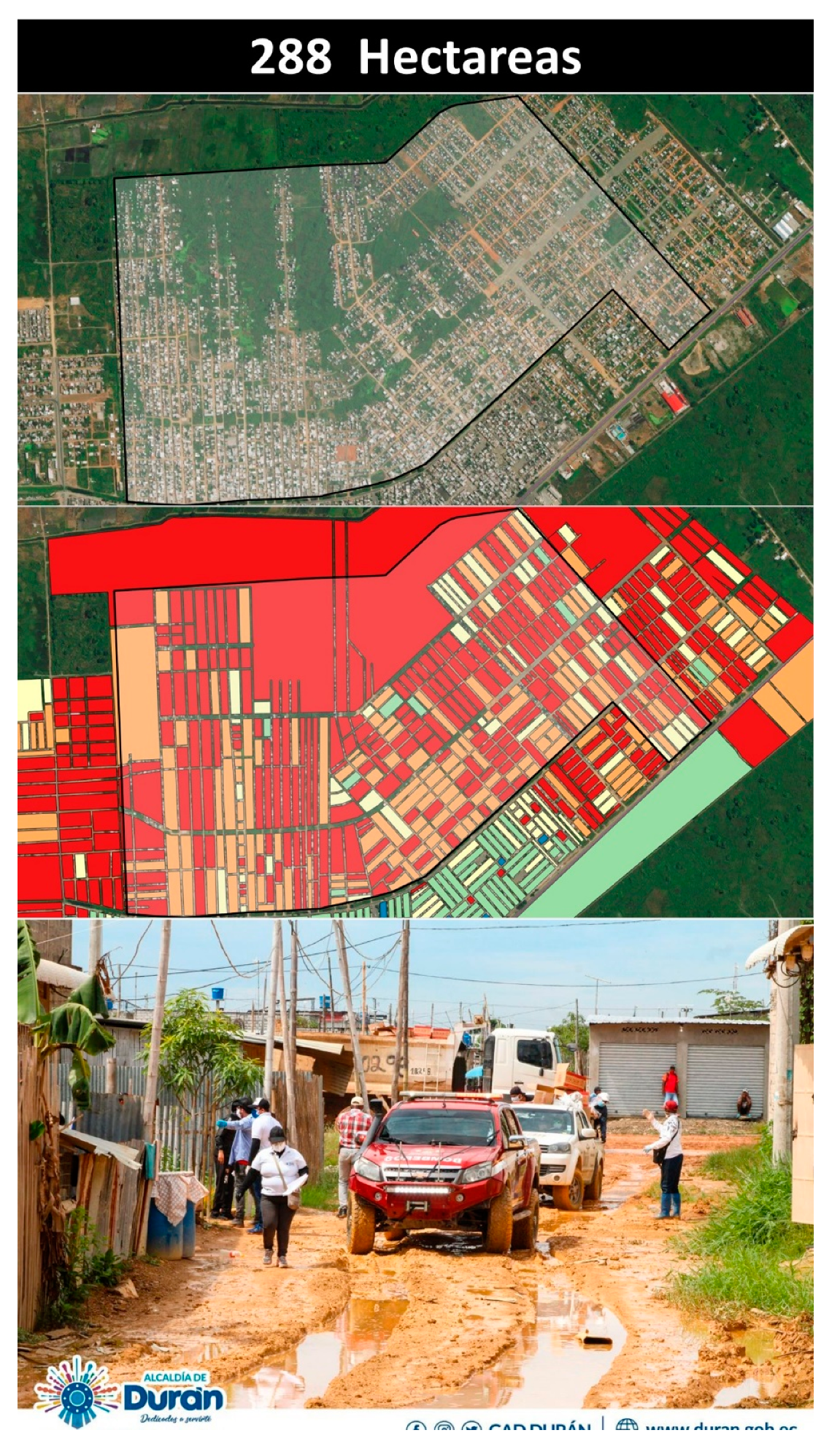
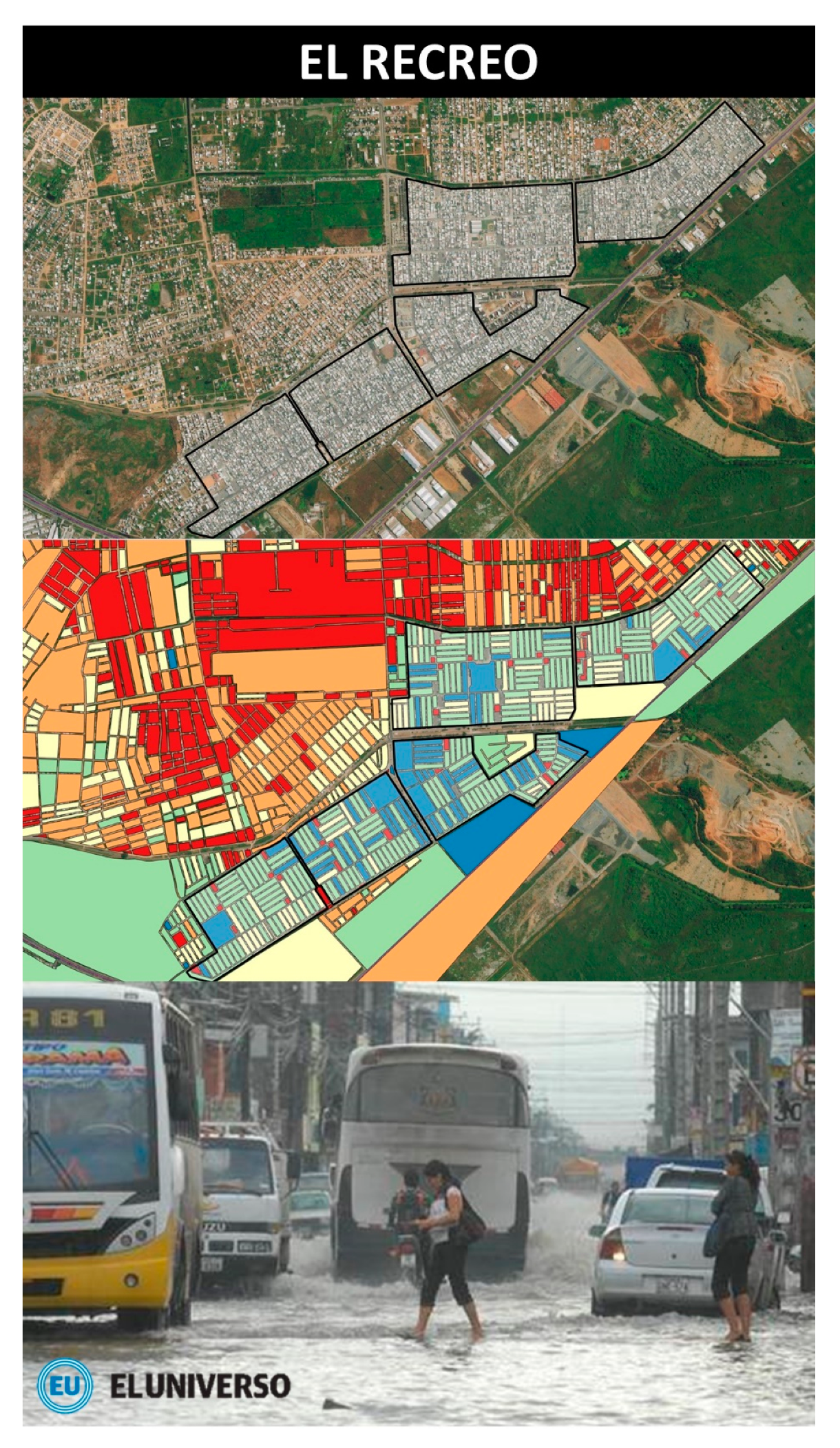
References
- Bulkeley, H.; Casta, V. A survey of urban climate change experiments in 100 cities. Glob. Environ. Chang. 2013, 23, 92–102. [Google Scholar] [CrossRef]
- Dawson, R.J.; Khan, M.S.A.; Gornitz, V.; Lemos, M.F.; Atkinson, L.; Pullen, J.; Osorio, J.C. Urban Areas in Coastal Zones. In Climate Change and Cities: Second Assessment Report of the Urban Climate Change Research Network; Rosenzweig, C., Solecki, W., Romero-Lankao, P., Mehrotra, S., Dhakal, S., Ali Ibrahim, S., Eds.; Cambridge University Press: New York, NY, USA, 2018; pp. 319–362. [Google Scholar]
- Hallegatte, S.; Green, C.; Nicholls, R.J.; Corfee-morlot, J. Future flood losses in major coastal cities. Nat. Clim. Chang. 2013, 3, 802–806. [Google Scholar] [CrossRef]
- Masson, V.; Marchadier, C.; Adolphe, L.; Aguejdad, R.; Avner, P.; Bonhomme, M.; Bretagne, G.; Briottet, X.; Bueno, B.; Munck, C. De Urban Climate Adapting cities to climate change: A systemic modelling approach. Urban Clim. 2014, 10, 407–429. [Google Scholar] [CrossRef]
- Wong, P.P.; Losada, I.J.; Gattuso, J.-P.; Hinkel, J.; Khattabi, A.; McInnes, K.L.; Saito, Y.; Sallenger, A. Coastal systems and low-lying areas. In Climate Change 2014: Impacts, Adaptation, and Vulnerability. Part A: Global and Sectoral Aspects. Contribution of Working Group II to the Fifth Assessment Report of the Intergovernmental Panel on Climate Change; Cambridge University Press: Cambridge, UK; New York, NY, USA, 2014; pp. 361–409. [Google Scholar]
- IPCC. Cambio climático 2014-Impactos, adaptación y vulnerabilidad. Resum. Para Las Responsab. Politicas 2014, 33. [Google Scholar] [CrossRef]
- Herath, H.M.M.; Wijesekera, N.T.S. A State-of-the-Art Review of Flood Risk Assessment in Urban Area. IOP Conf. Ser. Earth Environ. Sci. 2019, 281. [Google Scholar] [CrossRef]
- Meng, M.; Dabrowski, M.; Stead, D. Enhancing flood resilience and climate adaptation: The state of the art and new directions for spatial planning. Sustainability 2020, 12, 7864. [Google Scholar] [CrossRef]
- United Nations Office for Disaster Risk Reduction. Making Development Sustainable: The Future of Disaster Risk Management; United Nations Office for Disaster Risk Reduction (UNISDR): Geneva, Switzerland, 2015. [Google Scholar]
- Gobierno Autónomo Descentralizado del Cantón Durán Plan Estratégico Institucional. 2013. Available online: http://app.sni.gob.ec/snilink/sni/PORTAL_SNI/data_sigad_plus/sigadplusdiagnostico/0960001890001_PDOT%20Dur%C3%A1n%20Diagn%C3%B3stico%200960001890001_15-03-2015_09-33-07.pdf (accessed on 1 December 2020).
- INEC Empleo (Encuesta Nacional de Empleo, Desempleo y Subempleo-ENEMDU); Instituto Nacional de Estadísticas y Censos (INEC): Quito-Ecuador, Ecuador, 2016; pp. 47–63.
- INEC Resultados Censo 2010 de Población y Vivienda del Ecuador. Instituto Nacional de Estadística y Censos (INEC). Quito–Ecuador. 2010. Available online: https://www.ecuadorencifras.gob.ec/wp-content/descargas/Manu-lateral/Resultadosprovinciales/guayas.pdf (accessed on 20 October 2019).
- GAD Durán. PLAN DE DESARROLLO Y ORDENAMIENTO TERRITORIAL; Geografia Urbana: Durán, Ecuador, 2015. [Google Scholar]
- Reglamento al Código Orgánico del Ambiente; Lexis Finder: Quito, Ecuador, 2019; Volume 752, pp. 1–192.
- Gálvez, H.; Regalado, J. Comportamiento de las Precipitaciones en la Costa Ecuatoriana en el 2008. Acta Oceanográfica Del Pacífico; INOCAR: Guayaquil, Ecuador, 2009; pp. 3–6. [Google Scholar]
- Stenfert, J.G.; Rubaij Bouman, R.M.; Tutein Nolthenius, R.C.; Joosten, S. Flood Risk Guayaquil: A Critical Analysis on Inundations; Delft University of Technology, Department of Hydraulic Engineering, Faculty of Civil Engineering: Delft, The Netherlands, 2017. [Google Scholar]
- De Risi, R.; Jalayer, F.; De Paola, F.; Carozza, S.; Yonas, N.; Giugni, M.; Gasparini, P. From Flood Risk Mapping toward Reducing Vulnerability: The Case of Addis Ababa. Nat. Hazards 2020, 100, 387–415. [Google Scholar] [CrossRef]
- Zapata, C.; Puente, A.; García, A.; García-Alba, J.; Espinoza, J. The use of hydrodynamic models in the determination of the chart datum shape in a tropical estuary. Water 2019, 11, 902. [Google Scholar] [CrossRef]
- Espinoza, M.E. Gulf of Guayaquil Tidal Simulation Using Delft3D Hyrodinamic Model During an El Niño Event and Normal Conditions. Bachelor´s Thesis, Escuela Superior Politécnica del Litoral, Facultad de Ingeniería Marítima y Ciencias del Mar, Guayaquil, Ecuador, 2018; p. 69. [Google Scholar]
- Van Amerongen, D.; Mariotto, A.; Kaplan, M.G.; Guadagnoli, E. Appropriateness of coronary angiography after myocardial infarction among Medicare beneficiaries. Managed care versus fee for service. N. Engl. J. Med. 2001, 344, 774–775. [Google Scholar] [CrossRef]
- IPCC. Cambio Climático 2007; Informe de síntesis. Contribución de los Grupos de trabajo I, II y III al Cuarto Informe de evaluación del Grupo Intergubernamental de Expertos sobre el Cambio Climát; IPCC: Geneva, Switzerland, 2007; ISBN 9291693227. [Google Scholar]
- Wilhelmi, O.V.; Hayden, M.H. Connecting people and place: A new framework for reducing urban vulnerability to extreme heat. Environ. Res. Lett. 2010, 5. [Google Scholar] [CrossRef]
- Nasiri, H.; Yusof, M.J.M.; Ali, T.A.M.; Hussein, M.K.B. District flood vulnerability index: Urban decision-making tool. Int. J. Environ. Sci. Technol. 2019, 16, 2249–2258. [Google Scholar] [CrossRef]
- CAF. Índice de Vulnerabilidad y Adaptación al Cambio Climático en la Región de América Latina y el Caribe; Corporacion Andina de Fomento (CAF): Caracas, Venezuela, 2014. [Google Scholar]
- Stennett-Brown, R.K.; Stephenson, T.S.; Taylor, M.A. Caribbean climate change vulnerability: Lessons from an aggregate index approach. PLoS ONE 2019, 14, e0219250. [Google Scholar] [CrossRef] [PubMed]
- Noriega, O.; Rojas, Y.G.; Barrios, J.R. Análisis de la vulnerabilidad y el riesgo a inundaciones en la cuenca baja del río Gaira, en el Distrito de Santa Marta. Prospectiva 2011, 9, 93–102. [Google Scholar]
- Choez, B.D.B.; Ríos, S.J.C.; Del Valle, D.J.M. Analysis of the vulnerability to flooding in the Santa Ana de Vuelta larga Parish, province of Manabi, Ecuador. Investig. Geogr. 2019. [Google Scholar] [CrossRef]
- CIFFEN Estrategia Provincial del Cambio Climatico- Implementación de un Sistema de Información de Vulnerabilidad Sectorial de la Provincia de Guayas Frente al Cambio y la Variabilidad Climatica; Gobierno Autónomo Descentralizado Provincial del Guayas, Dirección de Medio Ambiente: Guayaquil, Ecuador, 2012.
- OECD. Handbook on Constructing Composite Indicators: Methodology and User Guide; OECD: Paris, France, 2008; ISBN 9789264043459. [Google Scholar]
- Fritzsche, K.; Schneiderbauer, S.; Bubeck, P.; Kienberger, S.; Buth, M.; Zebisch, M.; Kahlenborn, W. El Libro de la Vulnerabilidad. Concepto y Lineamientos Para la Evaluación Estandarizada de la Vulnerabilidad; Deutsche Gesellschaft für Internationale Zusammenarbeit (GIZ) GmbH: Bonn y Eschborn, Germany, 2017. [Google Scholar]
- Menezes, J.A.; Confalonieri, U.; Madureira, A.P.; De Brito Duval, I.; Dos Santos, R.B.; Margonari, C. Mapping human vulnerability to climate change in the Brazilian Amazon: The construction of a municipal vulnerability index. PLoS ONE 2018, 13, e0190808. [Google Scholar] [CrossRef]
- Brenkert, A.L.; Malone, E.L. Modeling vulnerability and resilience to climate change: A case study of India and Indian states. Clim. Chang. 2005, 72, 57–102. [Google Scholar] [CrossRef]
- Bigi, V.; Pezzoli, A.; Comino, E.; Rosso, M. A Vulnerability Assessment in Scant Data Context: The Case of North Horr Sub-County. Sustainability 2020, 12, 6024. [Google Scholar] [CrossRef]
- Defne, Z.; Aretxabaleta, A.L.; Ganju, N.K.; Kalra, T.S.; Jones, D.K.; Smith, K.E.L. A geospatially resolved wetland vulnerability index: Synthesis of physical drivers. PLoS ONE 2020, 15, e0228504. [Google Scholar] [CrossRef]
- de Almeida, L.Q.; de Araujo, A.M.S.; Welle, T.; Birkmann, J. DRIB Index 2020: Validating and enhancing disaster risk indicators in Brazil. Int. J. Disaster Risk Reduct. 2020, 42. [Google Scholar] [CrossRef]
- Papathoma-Köhle, M.; Cristofari, G.; Wenk, M.; Fuchs, S. The importance of indicator weights for vulnerability indices and implications for decision making in disaster management. Int. J. Disaster Risk Reduct. 2019, 36, 101103. [Google Scholar] [CrossRef]
- Bao, J.; Li, X.; Yu, C. The construction and validation of the heat vulnerability index, a review. Int. J. Environ. Res. Public Health 2015, 12, 7220–7234. [Google Scholar] [CrossRef] [PubMed]
- Papathoma-Köhle, M.; Schlögl, M.; Fuchs, S. Vulnerability indicators for natural hazards: An innovative selection and weighting approach. Sci. Rep. 2019, 9, 1–14. [Google Scholar] [CrossRef]
- Sitaula, B.K. Quantitative Assessment of Vulnerability to Climate Change in Rural Municipalities of Bosnia and Herzegovina. Sustainability 2017, 9, 1208. [Google Scholar] [CrossRef]
- Flores, C.M.F.; Hernández, V.H. Segregación socioespacial y accesibilidad al empleo en Ciudad Juárez, Chihuahua (2000–2004). Región y Sociedad 2015, 25. [Google Scholar] [CrossRef]
- Gbetibouo, G.A.; Ringler, C. Mapping South African Farming Sector Vulnerability to Climate Change and Variability: A Subnational Assessment; International Food Policy Research Institute (IFPRI): Washington, DC, USA, 2009; pp. 2–4. [Google Scholar]
- Martínez-noriegas, H.A.; Medrano-broche, B.E.; Fernández-, L.; Tejeda-rodríguez, Y.E.; Introducción, I. Análisis Multivariado De Datos Como Soporte a La Decisión En La Selección De Estudiantes En Proyectos De Software/Multivariate Data Analysis as Decision Making Support in Student Selection in Software Projects. Ing. Ind. 2013, 34, 130–142. [Google Scholar]
- Kirby, R.H. Measuring Social Vulnerability to Environmental Hazards in the Dutch Province of Zeeland. Master’s Thesis, Louisiana State University, Baton Rouge, LA, USA, 2015. [Google Scholar]
- Inostroza, L.; Palme, M.; De La Barrera, F. A heat vulnerability index: Spatial patterns of exposure, sensitivity and adaptive capacity for Santiago de Chile. PLoS ONE 2016, 11, e0162464. [Google Scholar] [CrossRef]
- Dickin, S.K.; Schuster-Wallace, C.J.; Elliott, S.J. Developing a Vulnerability Mapping Methodology: Applying the Water-Associated Disease Index to Dengue in Malaysia. PLoS ONE 2013, 8, e63584. [Google Scholar] [CrossRef]
- I Care Environnement. Vulnerabilidad y Adaptación al Cambio Climático en Guayaquil; CAF: Caracas, Venezuela, 2018; ISBN 9789804220999. [Google Scholar]
- Libélula Comunicación, Ambiente y Desarrollo Sac. Vulnerabilidad en Arequipa al Cambio Climático y Adaptación Metropolitana; CAF: Caracas, Venezuela, 2018; ISBN 9789804220609. [Google Scholar]
- Fekete, A. Validation of a social vulnerability index in context to river-floods in Germany. Nat. Hazards Earth Syst. Sci. 2009, 9, 393–403. [Google Scholar] [CrossRef]
- Factor Ideas Integral Services, S.L. Vulnerabilidad y adaptación al cambio climático en São Paulo. Caracas: CAF. 2018. Available online: http://scioteca.caf.com/handle/123456789/1349. (accessed on 1 December 2020).
- Stewart-ibarra, A.M.; Muñoz, Á.G.; Ryan, S.J.; Ayala, E.B.; Borbor-cordova, M.J. Spatiotemporal clustering, climate periodicity, and social-ecological risk factors for dengue during an outbreak in Machala, Ecuador, in 2010. BMC Infect. Dis. 2014, 1–16. [Google Scholar] [CrossRef]
- Zulaica, L.; Celemín, P. Análisis Territorial de las Condiciones de Habitabilidad en el Periurbano de la Ciudad de Mar del Plata (Argentina), a Partir de la Construcción de un Indice y de la Aplicación de Métodos de Asociación Espacial; Revista de Geografía: Norte Grande, Chile, 2008; pp. 129–146. [Google Scholar]
- Mancilla Flores, E.M. Aplicación del Redatam; Revista Varianza: La Paz, Bolivia, 1997; pp. 8–14. [Google Scholar]
- Xenarios, S.; Nemes, A.; Sarker, G.W.; Sekhar, N.U. Assessing vulnerability to climate change: Are communities in flood-prone areas in Bangladesh more vulnerable than those in drought-prone areas? Assessing vulnerability to climate change: Are communities in flood-prone areas in Bangladesh more vulnerab. Water Resour. Rural Dev. 2016, 7, 1–19. [Google Scholar] [CrossRef]
- Wajda, Ł.; Duda-Chodak, A.; Tarko, T.; Kamiński, P. Application of principal component analysis for the optimisation of lead(II) biosorption. World J. Microbiol. Biotechnol. 2017, 33, 1–10. [Google Scholar] [CrossRef] [PubMed]
- Beaumont, R. An Introduction to Principal Component Analysis & Factor Analysis Using SPSS 19 and R (psych Package). 2012. Available online: http://assessment-matters.weebly.com/blogs/an-introduction-toprincipal-component-analysis-factor-analysisusing-spss-19-and-r-psych-package (accessed on 15 May 2020).
- Sánchez, C.S.-G.; Nuñez Peiró, M.; Neila González, F.J. Isla de Calor Urbana y Población Vulnerable. El Caso De Madrid Sur; Universidad de Sevilla, Escuela Técnica Superior de Arquitectura: Sevilla, España, 2017; pp. 545–556. [Google Scholar]
- Enrique, J.; Bohórquez, T.; Enrique, J.; Bohórquez, T. Evaluación de la vulnerabilidad social ante amenazas naturales en Manzanillo (Colima). Un aporte de método; UNAM: Mexico City, Mexico, 2013; pp. 79–93. [Google Scholar]
- Salinas, P.H.; Albornoz, V.J.; Reyes, P.A.; Erazo, B.M.; Ide, V.R. Análisis de componentes principales aplicado a variables respecto a la mujer gestante en la región de las Américas. Rev. Chil. De Obstet. Y Ginecol. 2006, 71, 17–25. [Google Scholar] [CrossRef][Green Version]
- Cisneros, J.C.; Maribel, K.; Chimbo, O.; Trejo, C.A. Análisis factorial exploratorio como método multivariante para validación de datos académicos en plataformas virtuales; Revista Lasallista de Investigación: Caldas, Colombia, 2018; Volume 15. [Google Scholar] [CrossRef]
- Louloudis, G. The Worth of Hydro Geochemical Data Factor Analysis (PCA) in Interpretation of Underground Water Origin. Megalopolis Lignite Bearing Fields Mine Water and Regional Waters Relations Case Study. In Proceedings of the 15th International Conference on Environmental Science and Technology, Rhodes, Greece, 31 August–2 September 2017; pp. 72–82. [Google Scholar]
- Garrocho, C.; Socioecon, D.G.; Campos-alanís, J.; Socioecon, D.G. Análisis espacial de los inmuebles dañados por el sismo 19S-2017 en la Ciudad de México. Salud Pública, México 2018, 60, 31–40. [Google Scholar] [CrossRef]
- Consuelo, A.C.; Rangel, C.G.; Alanís, J.C. Análisis espacial de la segregación residencial de adultos mayores en la Zona Metropolitana del Valle de Toluca. Rev. De Urban. 2016, 27–45. [Google Scholar] [CrossRef][Green Version]
- Zulaica, L.; Ferraro, R. Vulnerability and Sustainability Dimensions in One Area of Mar de Plata Peri-Urban; Rev. De Geogr.: Mar del Plata, Argentina, 2010; pp. 197–219. [Google Scholar]
- Anselin, L. Interactive Techniques and Exploratory Spatial Data Analysis. 1996. Available online: https://www.geos.ed.ac.uk/~gisteac/gis_book_abridged/files/ch17.pdf (accessed on 10 January 2020).
- Anselin, L.; Syabri, I.; Kho, Y. GeoDa: An Introduction to Spatial Data Analysis. In Geographical Analysis; Department of Geography, University of Illinois: Champaign, IL, USA, 2006; Volume 38, pp. 5–22. [Google Scholar]
- Wang, F.; Xu, Z.; Sun, R.; Gong, Y.; Liu, G.; Zhang, J.; Wang, L.; Zhang, C.; Fan, S.; Zhang, J. Genetic dissection of the introgressive genomic components from Gossypium barbadense L. that contribute to improved fiber quality in Gossypium hirsutum L. Mol. Breed. 2013, 32, 547–562. [Google Scholar] [CrossRef]
- Abdi, H.; Williams, L.J. Principal component analysis. Wiley Interdiscip. Rev. Comput. Stat. 2010, 2, 433–459. [Google Scholar] [CrossRef]
- Chen, T.; Wilson, L.T.; Liang, Q.; Xia, G.; Chen, W.; Chi, D. Influences of irrigation, nitrogen and zeolite management on the physicochemical properties of rice. Arch. Agron. Soil Sci. 2017, 63, 1210–1226. [Google Scholar] [CrossRef]
- Reglamento de Ley de Ordenamiento Territorial, Uso y Gestión de Suelo; Lexis Finder: Quito, Ecuador, 2019; pp. 1–30.
- Lankao, P.R.; Nychka, D.; Tribbia, J. Development and greenhouse gas emissions deviate from the ‘modernization’ theory and ‘convergence’ hypothesis. Clim. Res. 2008, 38, 17–29. [Google Scholar] [CrossRef]
- Lampis, A.; Fraser, A. The Global Urban Economic Dialogue Series Climate Change; United Nations Human Settlements Programme (UN-HABITAT): Nairobi, Kenya, 2012; ISBN 9789211320275. [Google Scholar]
- Castillo, R.; Jácome, F. Medición de la Pobreza Multidimensional en Ecuador, Capítulo 10, Reporte de pobreza por consumo 2006–2014; INEC: Quito, Ecuador, 2015; pp. 352–366. ISBN 978-9942-22-026-4. [Google Scholar]
- Ran, J.; MacGillivray, B.H.; Gong, Y.; Hales, T.C. The application of frameworks for measuring social vulnerability and resilience to geophysical hazards within developing countries: A systematic review and narrative synthesis. Sci. Total Environ. 2020, 711, 134486. [Google Scholar] [CrossRef]
- Xiong, J.; Li, J.; Cheng, W.; Wang, N.; Guo, L. A GIS-based support vector machine model for flash flood vulnerability assessment and mapping in China. ISPRS Int. J. Geo-Inf. 2019, 8, 297. [Google Scholar] [CrossRef]
- Müller, A.; Reiter, J.; Weiland, U. Assessment of urban vulnerability towards floods using an indicator-based approach-a case study for Santiago de Chile. Nat. Hazards Earth Syst. Sci. 2011, 11, 2107–2123. [Google Scholar] [CrossRef]
- Romero-Lankao, P.; Hughes, S.; Qin, H.; Hardoy, J.; Rosas-Huerta, A.; Borquez, R.; Lampis, A. Scale, urban risk and adaptation capacity in neighborhoods of Latin American cities. Habitat Int. 2014, 42, 224–235. [Google Scholar] [CrossRef]
- Chen, W.; Cutter, S.L.; Emrich, C.T.; Shi, P. Measuring social vulnerability to natural hazards in the Yangtze River Delta region, China. Int. J. Disaster Risk Sci. 2013, 4, 169–181. [Google Scholar] [CrossRef]
- Friedmann, J.; Miller, J. The Urban field. Urban Theory 2017, 73–94. [Google Scholar] [CrossRef]
- Wölfer, R. Analysis of the Subsurface Urban Drainage Systems for Durán City, Ecuador. Master’s Thesis, Magdeburg-Stendal University of Applied Sciences, Magdeburg, Germany, 2019. [Google Scholar]
- Koks, E.E.; Jongman, B.; Husby, T.G.; Botzen, W.J.W. Combining hazard, exposure and social vulnerability to provide lessons for flood risk management. Environ. Sci. Policy 2015, 47, 42–52. [Google Scholar] [CrossRef]
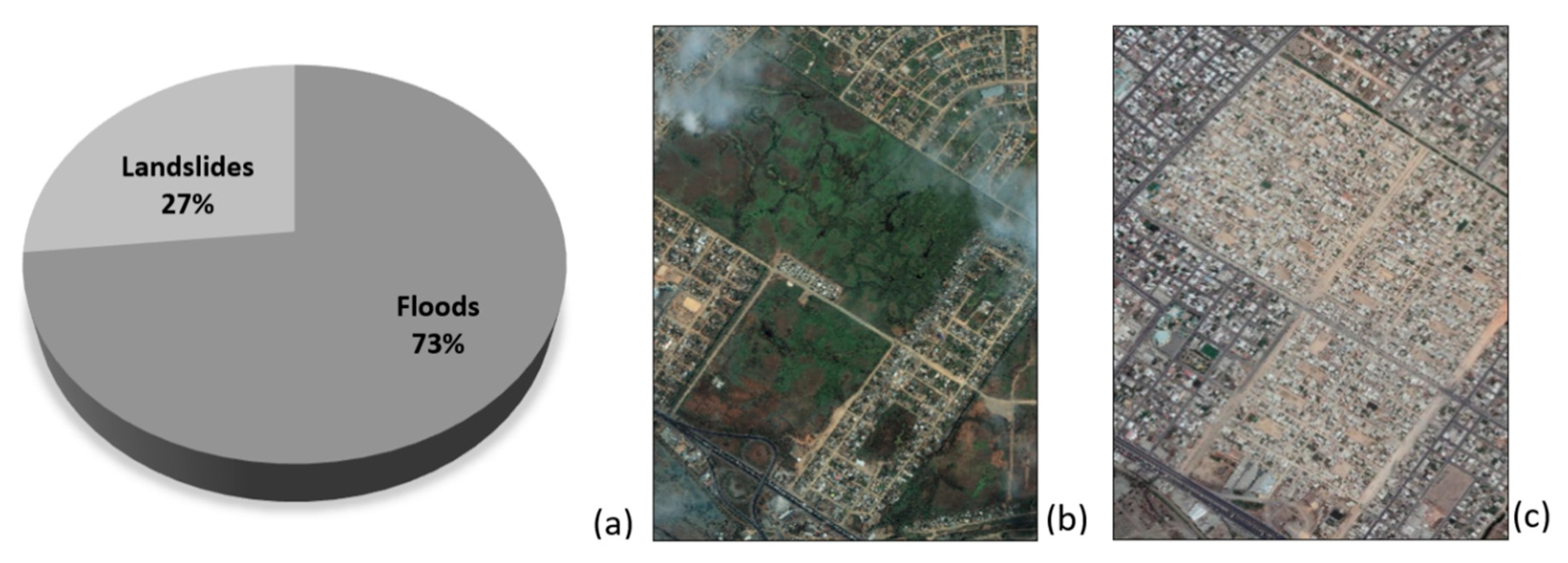
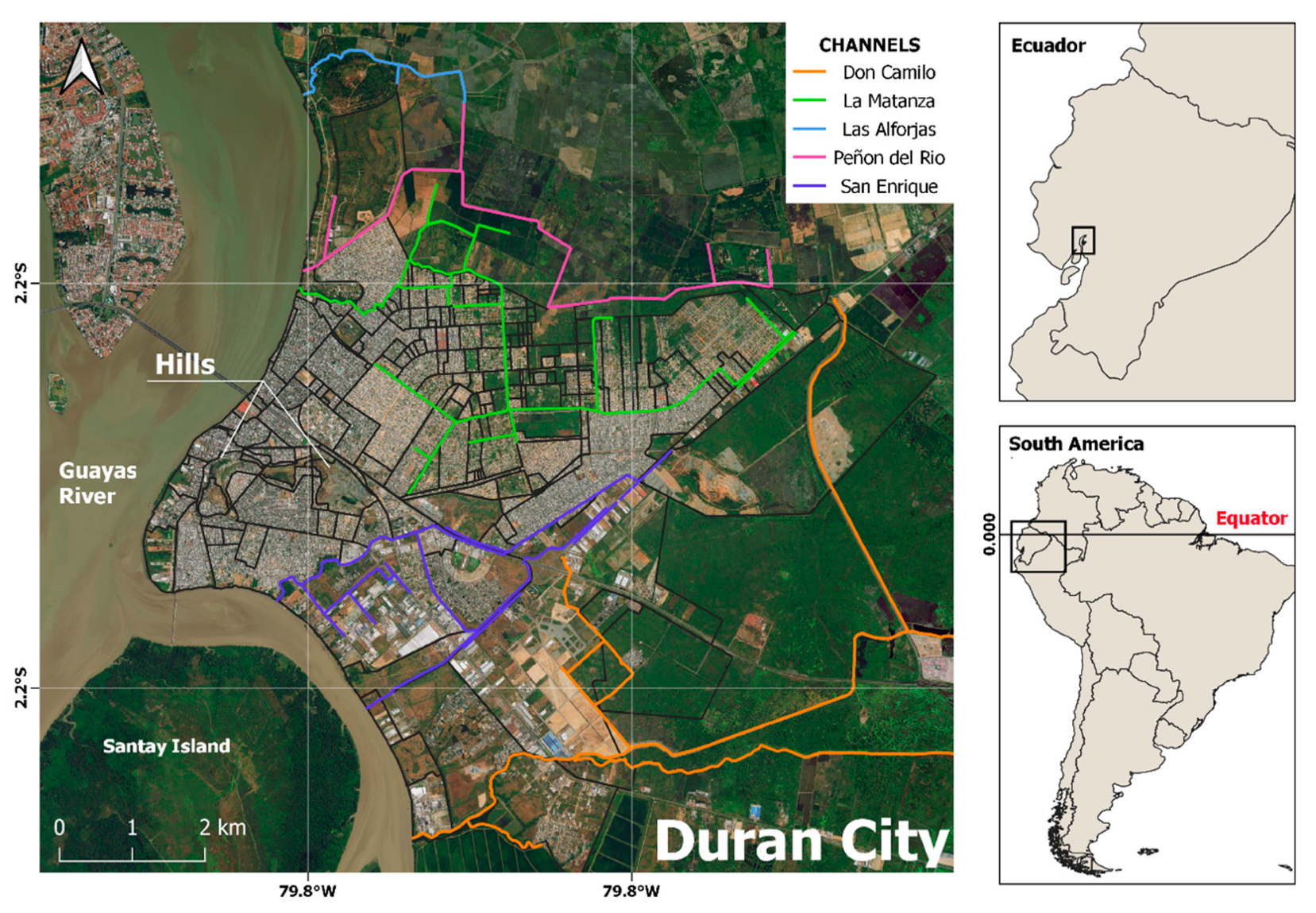
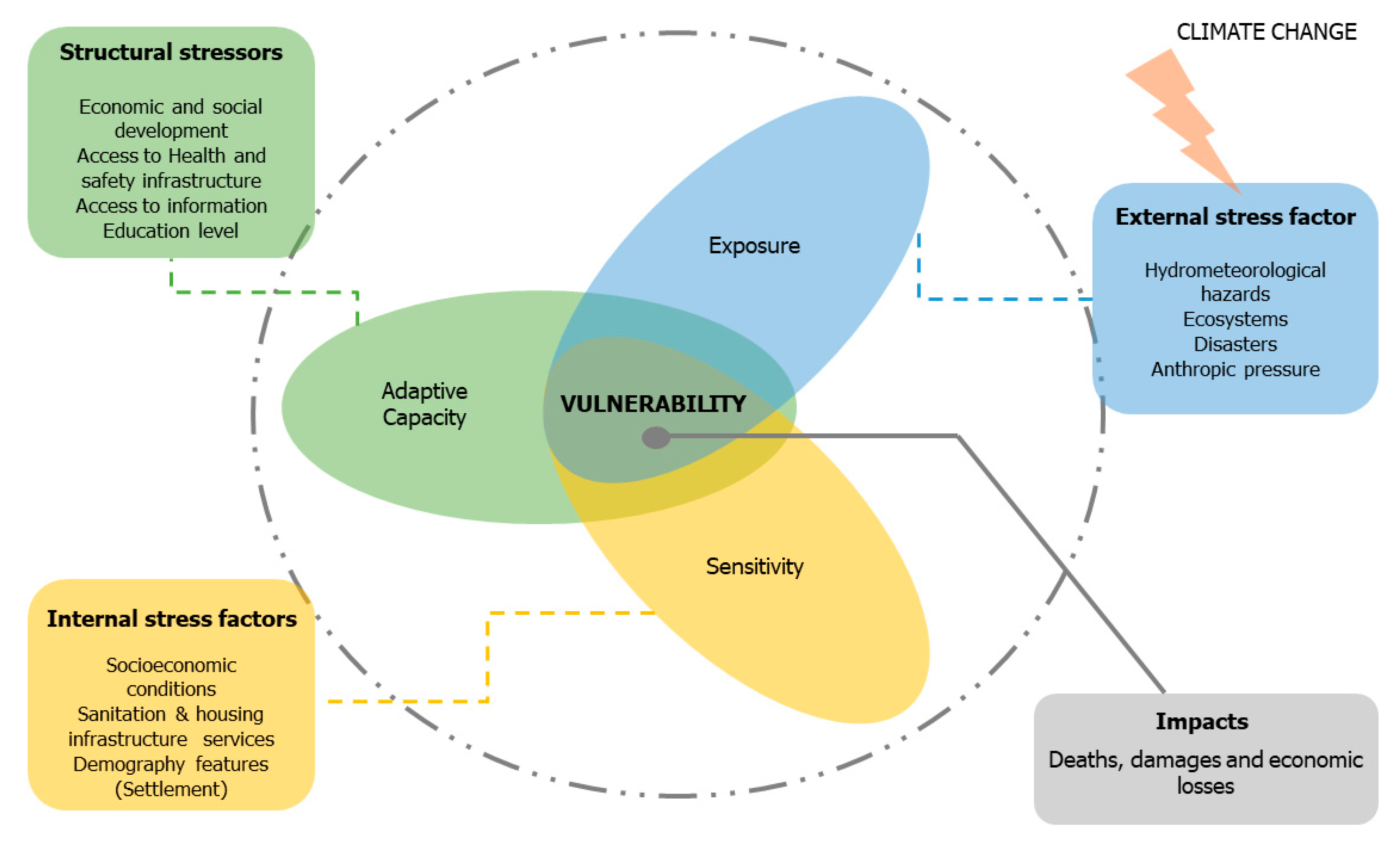
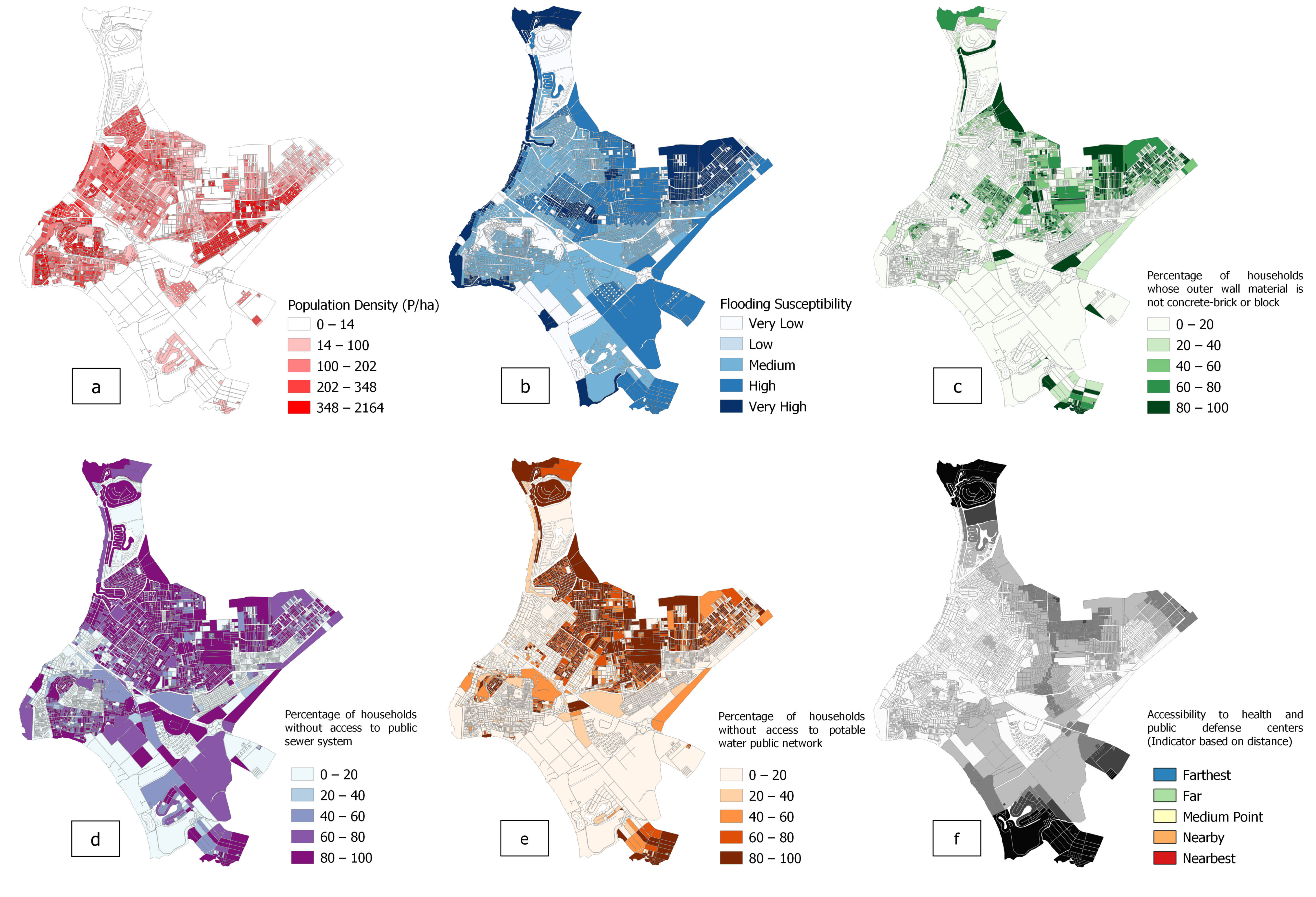
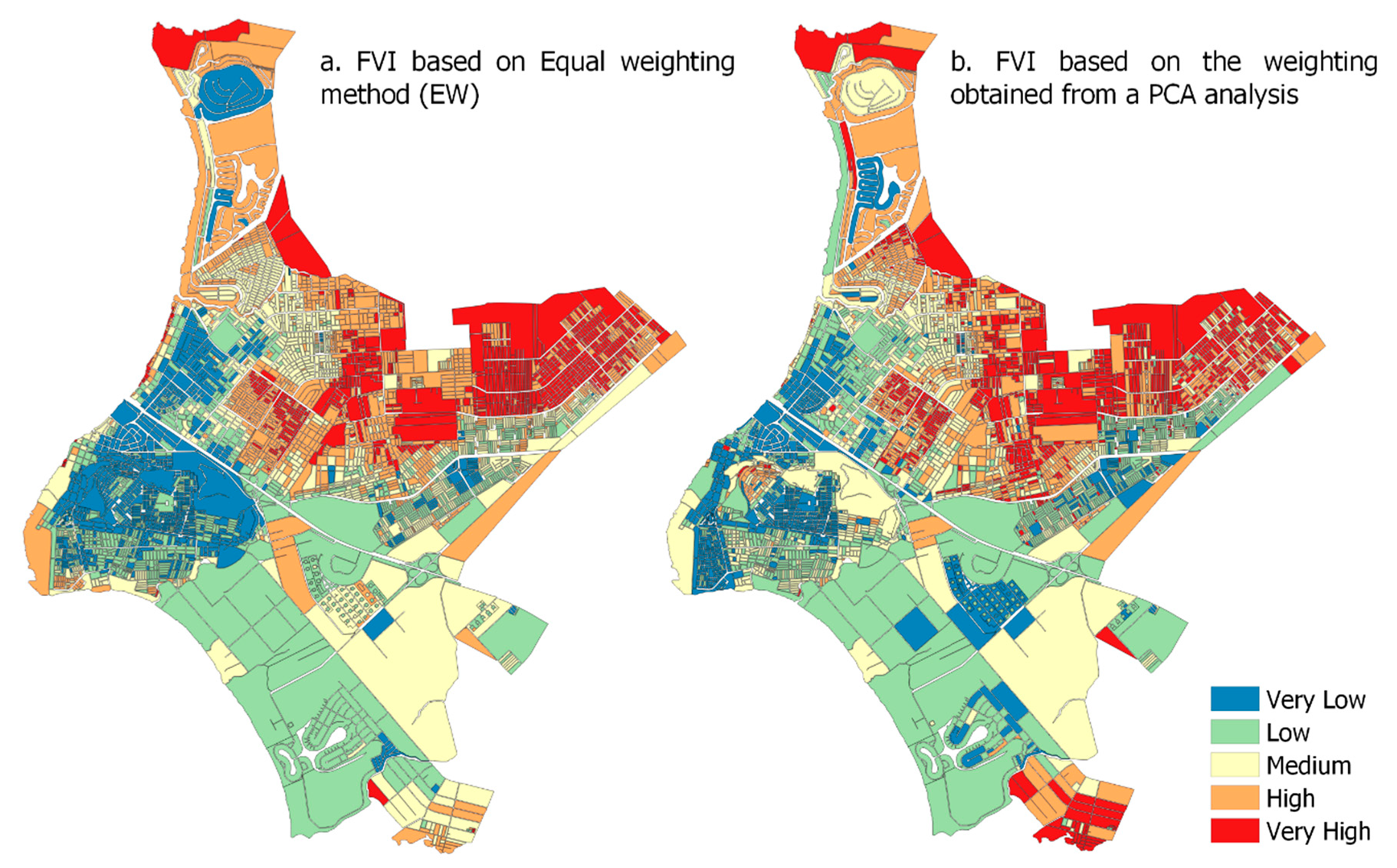
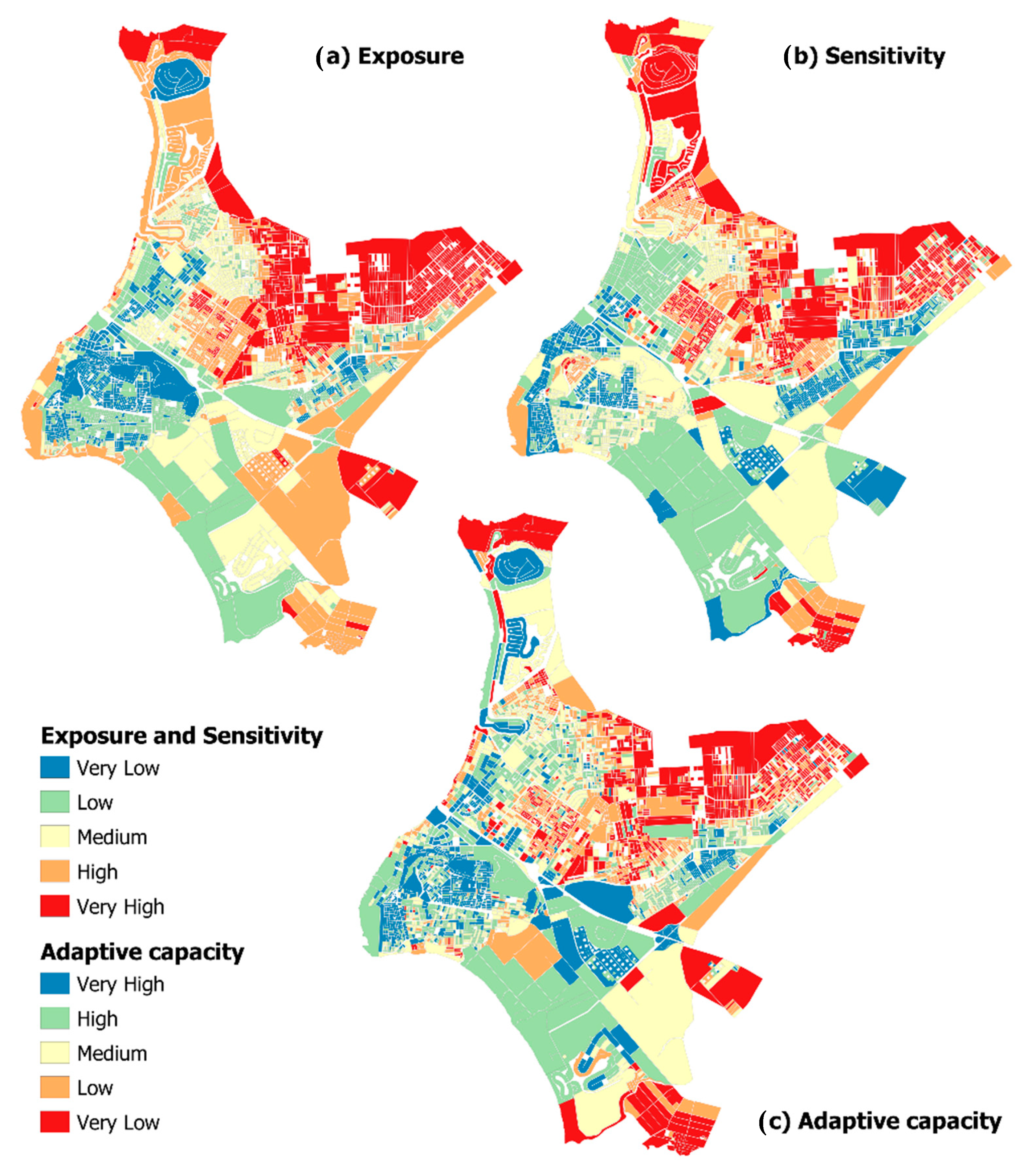
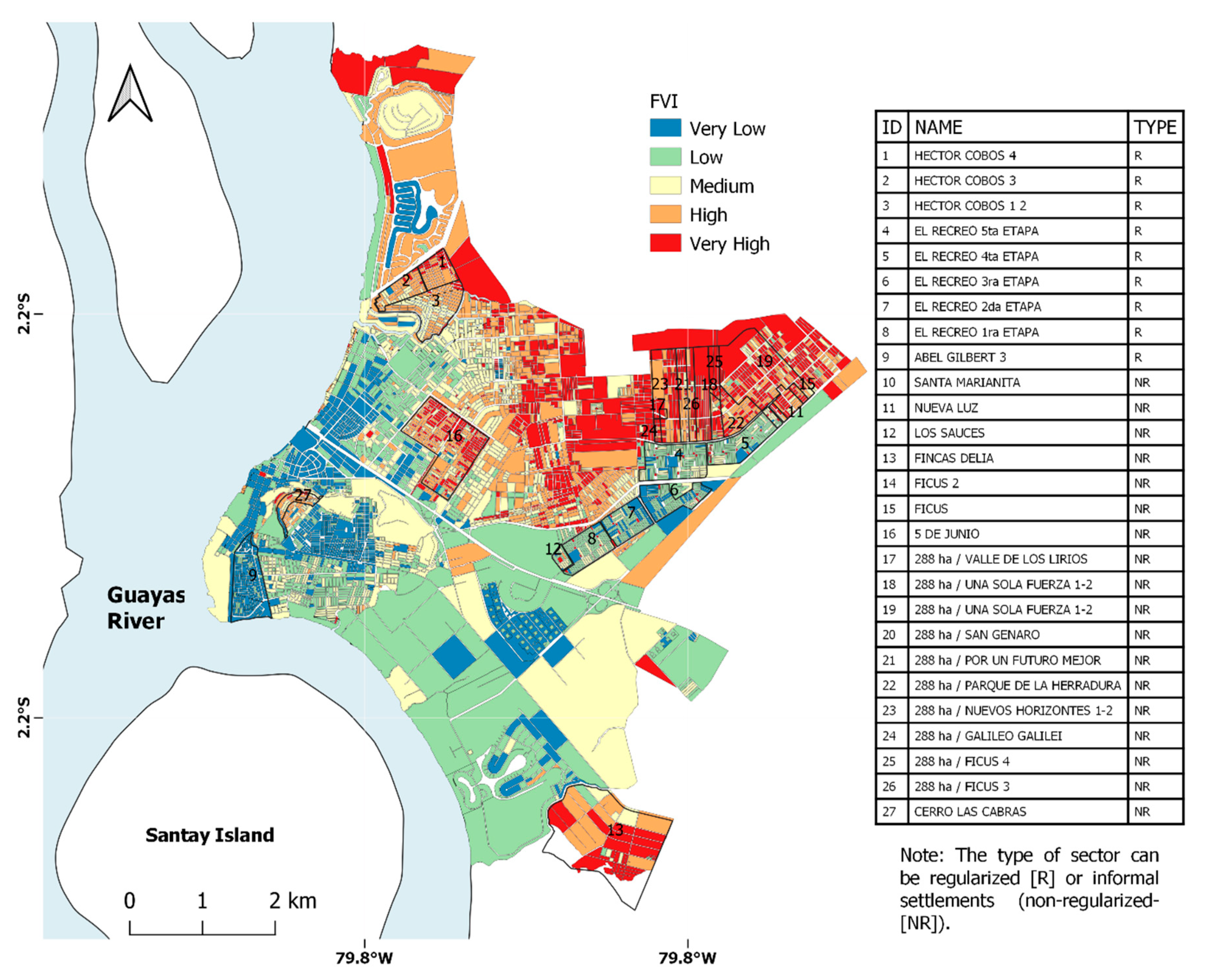
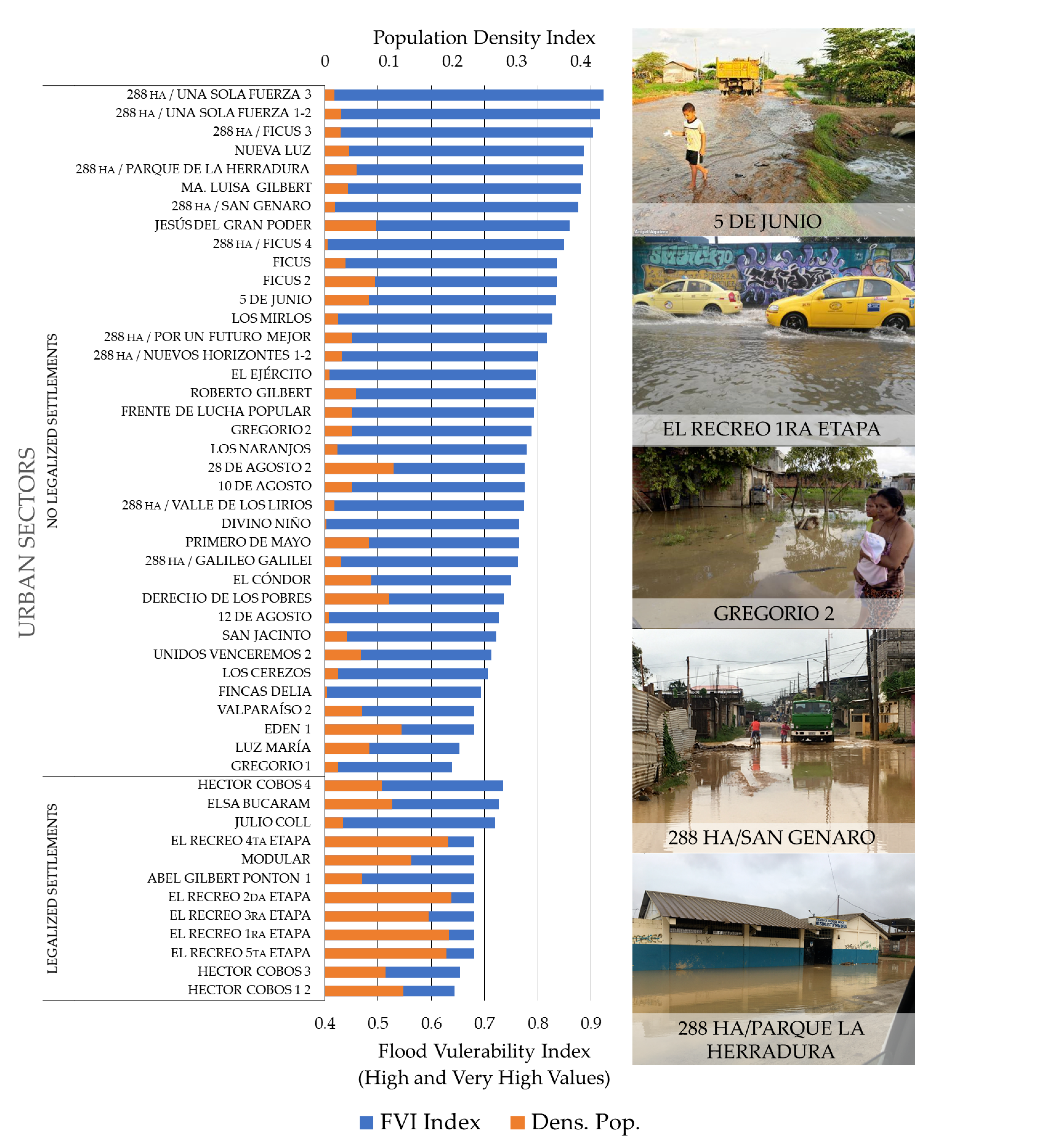
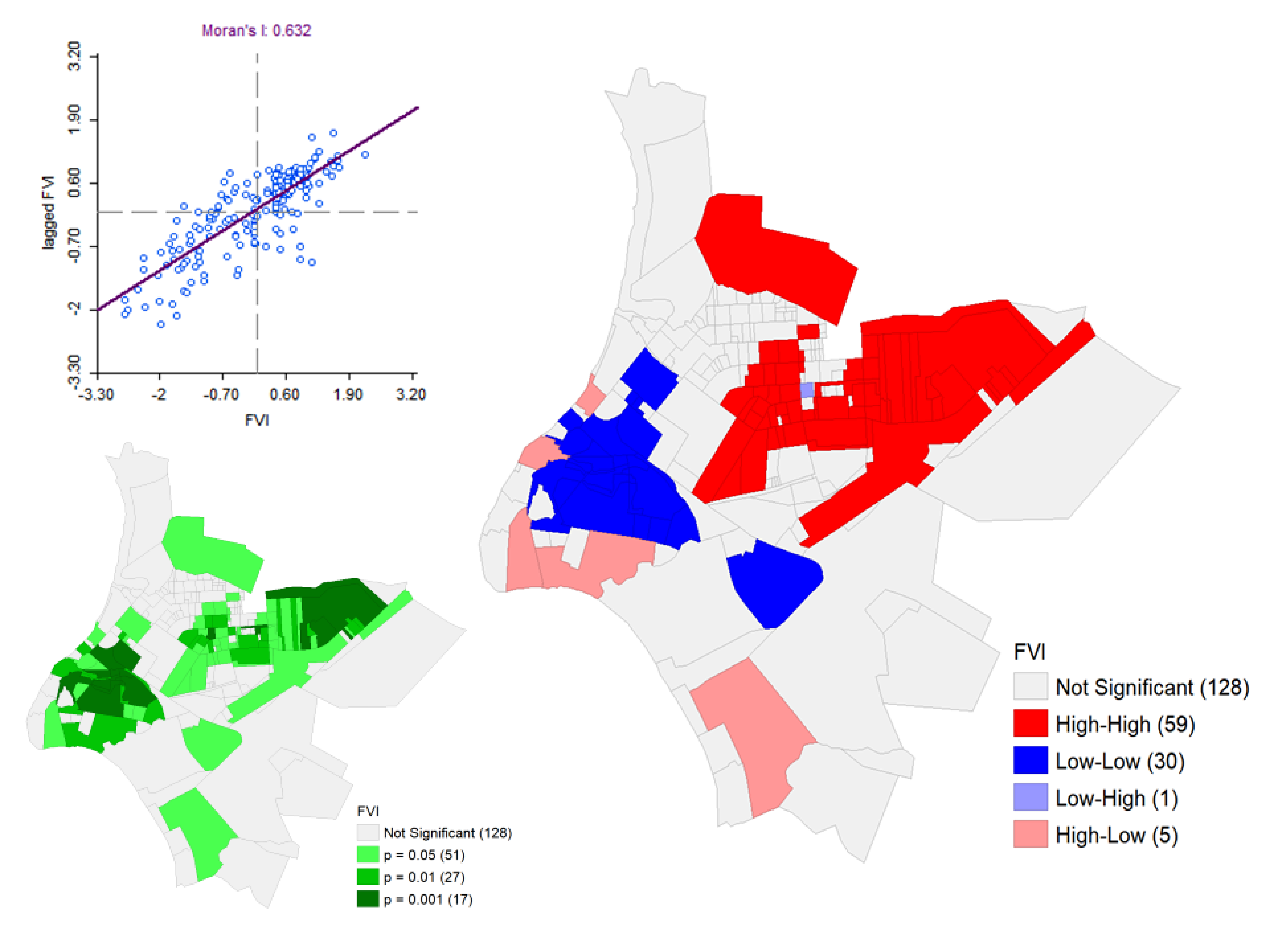
| Indexes | Description |
|---|---|
| aExposure | Susceptibility to flooding (SF 100 yrs) |
| Occurrence of at least one flood event (yes-1, no-0) (Flo Eve) | |
| Digital Elevation Models (DEM) | |
| Population density (Pop Dens) | |
| bSensitivity or susceptibility | Percentage of population that cannot read or write (%Pop illit) |
| Percentage of disabled population (%Pop Disab) | |
| Percentage of the population that is not economically active (People under the age of 14 and over 65, relative to the total population) (%Dep Age) | |
| Percentage of homes that do not have access to cobbled or concrete streets or roads (%Hou way) | |
| Percentage of homes whose external wall material is not concrete-brick or block (%Hou wall) | |
| Percentage of homes without access to safe drinking water by public network (%Houwater) | |
| Percentage of homes without access to public sewerage system (%Hou sewar) | |
| Percentage of homes without access to electricity (%Hou elect) | |
| Percentage of homes without garbage collection system per collection cart (%Hou garba) | |
| cAdaptive capacity | Percentage of population with access to public or private health insurance (%Pop healt) |
| Percentage of population that has access to communication technologies, population that used telephone or internet (highest value variable is selected) (%Pop techn) | |
| Percentage of the population whose level of education is post-baccalaureate, higher or postgraduate validated by the national education system. (%Pop educates) | |
| Percentage of population engaged in administrative, support, public administration defense and human health care activities (%Pop actHD) | |
| Access to health and public defense facilities, depending on distance. The closer the centroid is to one block from these facilities, the less the vulnerability (Pop acces) |
| Components | Variables | W (PCA) | W (EW) | Mean | Sd |
|---|---|---|---|---|---|
| Exposure | SF 5 yrs | 0.654 | 0.25 | 3.529 | 0.926 |
| Flo Eve | 0.402 | 0.25 | 0.091 | 0.288 | |
| Dem | 0.738 | 0.25 | 1.928 | 0.777 | |
| Pop Dens | 0.527 | 0.25 | 222.288 | 191.168 | |
| Sensitivity | %Pop illit | 0.359 | 0.111 | 4.426 | 6.452 |
| %Pop Disab | 0.444 | 0.111 | 5.682 | 7.261 | |
| %Dep Age | 0.508 | 0.111 | 34.312 | 12.728 | |
| %Hou way | 0.723 | 0.111 | 62.524 | 43.601 | |
| %Hou wall | 0.808 | 0.111 | 24.641 | 31.478 | |
| %Hou water | 0.775 | 0.111 | 42.013 | 40.504 | |
| %Hou sewar | 0.693 | 0.111 | 59.174 | 38.709 | |
| %Hou elect | 0.678 | 0.111 | 15.106 | 26.329 | |
| %Hou garba | 0.759 | 0.111 | 22.890 | 31.037 | |
| Adaptive capacity | %Pop health | 0.572 | 0.20 | 21.326 | 15.420 |
| %Pop techn | 0.506 | 0.20 | 48.782 | 18.403 | |
| %Pop educates | 0.543 | 0.20 | 7.225 | 9.053 | |
| %Pop actHD | 0.373 | 0.20 | 3.993 | 5.632 | |
| Pop acces | 0.654 | 0.20 | 4.464 | 0.850 |
| Urban Sector & Level of Vulnerability | Exposure | Sensitivity | Adaptive Capacity |
|---|---|---|---|
| 288 Ha Una Sola Fuerza 1, 2 and 3 High and very high vulnerability | Lowlands, previous wetlands or rice paddies, recurrent flooding events, low population density. | Slums with bad housing, lacking city services as water, sewage, road access. According to census data there are young families with children. | Low levels of education, informality, lacking social security, and far from health and city services. Limited community organization. |
| El Recreo 1, 2, 3 4, and 5 Medium vulnerability | Lowlands, chronic recurrent flooding events, higher population density. | Government housing program with basic city services, water, urban sewage, paved roads. There are different groups ages and members of the same family living in the same plot, building additional apartments in the same plot. | Higher levels of education, better access to social security, health centers and a more organized community. |
Publisher’s Note: MDPI stays neutral with regard to jurisdictional claims in published maps and institutional affiliations. |
© 2020 by the authors. Licensee MDPI, Basel, Switzerland. This article is an open access article distributed under the terms and conditions of the Creative Commons Attribution (CC BY) license (http://creativecommons.org/licenses/by/4.0/).
Share and Cite
Borbor-Cordova, M.J.; Ger, G.; Valdiviezo-Ajila, A.A.; Arias-Hidalgo, M.; Matamoros, D.; Nolivos, I.; Menoscal-Aldas, G.; Valle, F.; Pezzoli, A.; Cornejo-Rodriguez, M.d.P. An Operational Framework for Urban Vulnerability to Floods in the Guayas Estuary Region: The Duran Case Study. Sustainability 2020, 12, 10292. https://doi.org/10.3390/su122410292
Borbor-Cordova MJ, Ger G, Valdiviezo-Ajila AA, Arias-Hidalgo M, Matamoros D, Nolivos I, Menoscal-Aldas G, Valle F, Pezzoli A, Cornejo-Rodriguez MdP. An Operational Framework for Urban Vulnerability to Floods in the Guayas Estuary Region: The Duran Case Study. Sustainability. 2020; 12(24):10292. https://doi.org/10.3390/su122410292
Chicago/Turabian StyleBorbor-Cordova, Mercy J., Geremy Ger, Angel A. Valdiviezo-Ajila, Mijail Arias-Hidalgo, David Matamoros, Indira Nolivos, Gonzalo Menoscal-Aldas, Federica Valle, Alessandro Pezzoli, and Maria del Pilar Cornejo-Rodriguez. 2020. "An Operational Framework for Urban Vulnerability to Floods in the Guayas Estuary Region: The Duran Case Study" Sustainability 12, no. 24: 10292. https://doi.org/10.3390/su122410292
APA StyleBorbor-Cordova, M. J., Ger, G., Valdiviezo-Ajila, A. A., Arias-Hidalgo, M., Matamoros, D., Nolivos, I., Menoscal-Aldas, G., Valle, F., Pezzoli, A., & Cornejo-Rodriguez, M. d. P. (2020). An Operational Framework for Urban Vulnerability to Floods in the Guayas Estuary Region: The Duran Case Study. Sustainability, 12(24), 10292. https://doi.org/10.3390/su122410292









